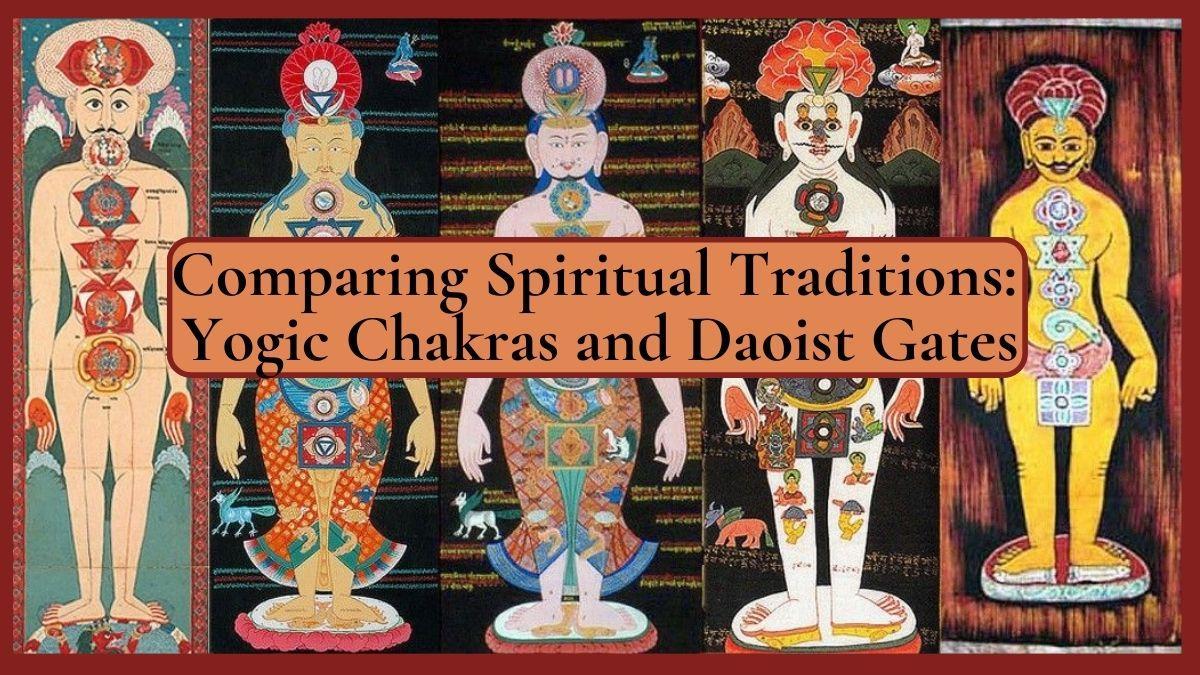 How are the Daoist Energy gates similar to Yogic chakras? Did these two traditions arise from a common origin in Tibet? And do these subtle body centers correspond to points on our physical anatomy?
How are the Daoist Energy gates similar to Yogic chakras? Did these two traditions arise from a common origin in Tibet? And do these subtle body centers correspond to points on our physical anatomy?
If you practice Yoga or Qigong, you already know the energy body is a powerful tool to activate the spirit. As I practice both systems, striking similarities and critical differences stand out. My innate curiosity invites me to compare them. Which system is best? Which one do YOU prefer? Was there a common source of both systems? Which one will best carry you to the flowering of your awareness efficiently and elegantly? That’s the question! My interest is drawn to the most ancient and powerful seed tradition rather than more modern interpretations, which may be watered-down versions of something deeper. In our quest for the roots of Asian spiritual systems, we have many challenges. Ha Ha!
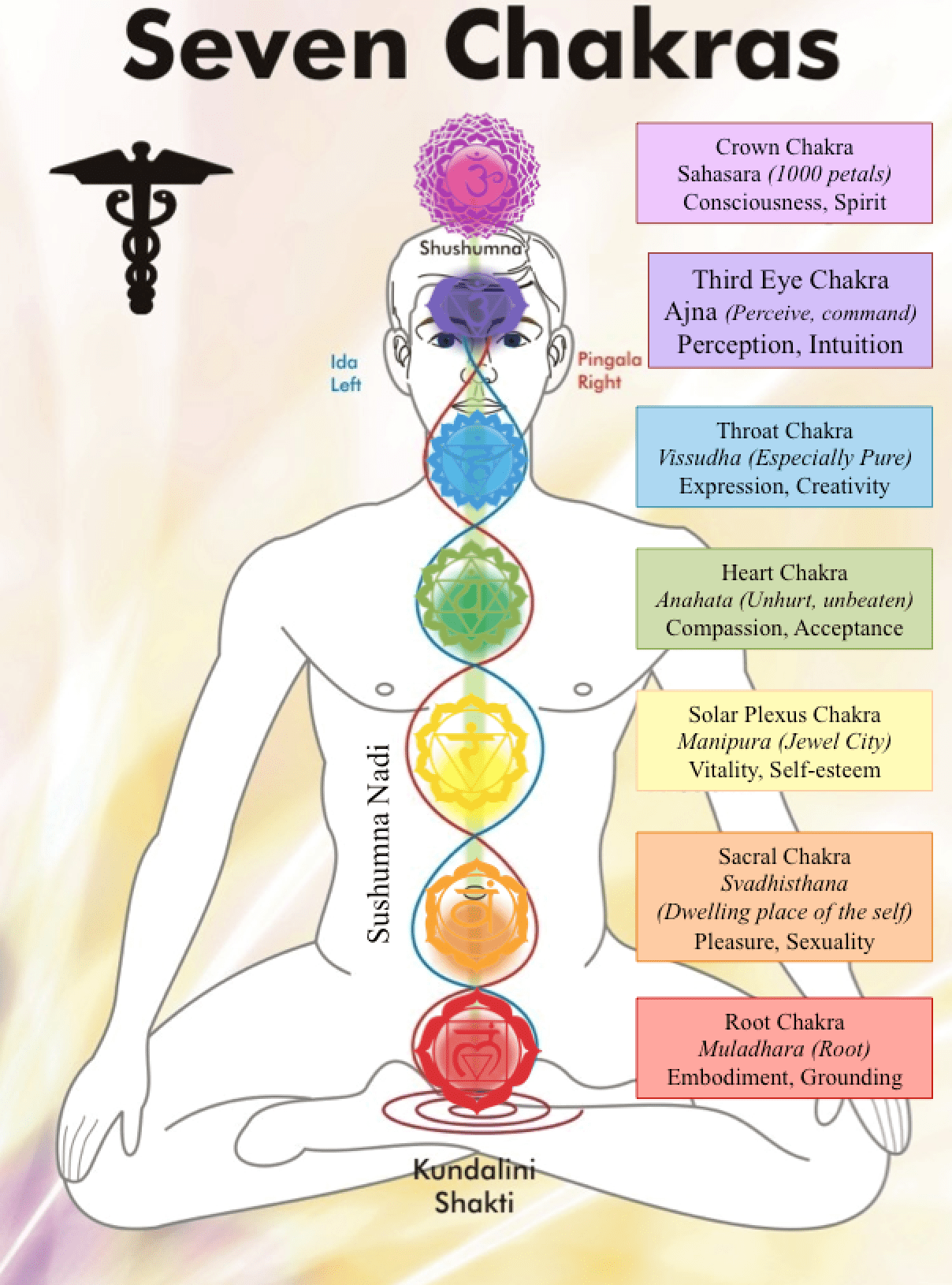 What are the Yogic Chakras?
What are the Yogic Chakras?
Over the past 150 years, the concept of chakras, has seized the Western imagination more than virtually any other aspect of the vast yogic tradition. Yet, just like other practices from Sanskrit sources, the majority of Westerners totally fail to grasp the original concept of chakras and how to use them as a tool for spiritual development. Indian concepts also have been largely “Westernized” after the British colonization starting in the 1600’s, and more strongly after Indians became British subjects in 1858. So at this point it is nearly impossible to find any form of yoga in India not influenced by Euro-American ideas about it. Indeed almost all the teachings on yoga in India today exist in the English language.
Surprisingly, our limited understanding of chakras comes mostly from a flawed 1918 translation by John Woodroffe, of a text about chakras written in Sanskrit in 1577 by an Indian scholar named Pūrṇānanda Yati. Was it divinely revealed? What was his background?
In the ancient tradition, there’s not just one chakra system, but many! Yes, the theory of the subtle energy centers called cakras (or padmas, ādhāras, lakṣyas, etc.) comes from the tradition of Tantric Yoga which may have originated in Tibet, flourished in India from 600-1300 CE, and is still alive today. After the year 900 CE, every one of the many branches of Tantric Yoga described a different chakra system. There were many systems. Five-chakra systems, six-chakra systems, seven, nine, ten, fifteen, twenty-one, twenty-eight and more chakras were taught, depending on what lineage you’re following. The seven-chakra system that Western yogis know became dominant around the 16th century.
Modern teachings on the chakras tend to describe them in fixed terms, colors, and psychological states. For example ‘the mūlādhāra chakra is at the base of the spine. It is said to have four petals, is the color red, and rules our survival, safety, embodiment and grounding’. All these associations of the chakras with psychological states is a modern Western innovation that started with Karl Jung. But the original Sanskrit sources did not teach this. There were myriad other ways to use the chakras, most importantly to function as a template for nyāsa, the installation of mantras and deity energies at specific points of the subtle body. These sacred sounds, your own deity or deities, along with each petal of lotus formed the framework of inner concentration on a chakra.
 Tibetan Chakras
Tibetan Chakras
The Tibetan Bön tradition has its roots in ancient Shamanism. Bön was founded by the earliest known Buddha, Tonpa Shenrab Miwoche 18,000 years ago. The Bön tradition is still alive and well, in spite of persecution and suppression by Tibetan Buddhists in the 7th to 10th centuries CE. However very little evidence remains of the early practices. The teachings of Padmasambhava, who founded Tibetan Buddhism, bringing Sanskrit and Indian practices to Tibet in the 7th century CE, included the meridians running vertically through the body from the Root to the Crown with braided junctures at each of the chakras. The word chakra means wheel. The spokes on each wheel would indicate the number of channels which connect directly to a chakra. The Tibetan Five-Wheeled Model of the Chakras includes the Root, Navel, Heart, Throat, and Crown. (See top image.)
Tantric Buddhism (or Vajrayana) broke off from the Indian Tantric tradition at a very early stage. Hence they developed a different version of the chakras. Tibetan Buddhism acknowledges four (navel, heart, throat, and head), five, seven, or even ten chakras or “channel wheels”, each having a different number of “spokes” to its Indian Tantric counterpart. The navel chakra for example has sixty-four spokes, the heart chakra eight, the throat sixteen (the only one to agree with the Hindu scheme), and the head or crown chakra thirty-two.
Do the Daoist and Yogic Traditions have a Common Origin in Tibet?
The history begins somewhere between 20,000 and 6,000 years ago, so if you’re channeling the answers, the results will vary depending on where your spaceship lands, and in what century. Presumably China would have been inundated in the biblical flood about 6,500 years ago (along with India, the Middle East and much of Europe). Hence all these traditions might have been newly introduced and evolved after the flood. Perhaps, perhaps all the Eastern traditions developed from a common source in the high mountains of Tibet.
Daoism has always been intimately linked to Chinese medicine and meridians.
However finding the “REAL” or “TRUE” energy gates and pathways in the ancient tradition will carry you far and wide, and will depend on your lineage of teachers, family, or geographic location. China is a big country, and centuries of local evolution of medical and spiritual practices gave rise to huge variations in language, philosophy, names of points, energy gates, and generally total disagreement on terms and methods. Here I have tried to assemble the most ancient, currently accepted, prevalent, and most logical Daoist gates based on traditional texts and my own lineages. I find this particular system to be extremely powerful, and now my preferred base for spiritual practice. But be prepared, as every teacher will have a different version of the Daoist system. Once again, the question is: Which system will carry you to the flowering of your awareness most efficiently and elegantly? Ha ha! After working with both Yogic and Daoist system for decades, this Daoist system is my favorite. Try it and let me know your experience.
Why Is the Daoist System Unknown in the West?
Although the British tried to dominate China in the colonial period, they failed in that effort, and were mainly a trading partner. For that reason, Western grasp of Chinese spiritual practices is perhaps centuries behind our understanding of Indian Yogic traditions. English writings about Daoist practices are rare even now. The tradition is mainly passed from teacher to student in person, with few ancient texts in translation. Chinese is a complex language of innuendos and double meanings, hence translations do not facilitate Western didactic thinking, and interpretations vary widely.
Striking Differences of Yogic and Daoist Systems
The Daoist energetic system is linked to the Extraordinary meridians. This system shows the subtle body flow beginning at the base in Hiuyin or perineum, coming up the back of the body with the Yang Du Mai channel. It goes over the top of the head to the upper gums. The flow goes down the front with the Yin Ren Mai Channel. The Chong Mai Channel (sometimes called the Taichi Pole) in the center of the body connects the top and bottom vertically. Thus The Daoist points are both on the front and back of the body, with a pole in the middle. The energy gathers and coalesces at Xia Dantien, or lower Elixir field near the navel, building kidney Jing and physical health. In most Daoist traditions, the breath begins at the bottom, up the back to the top, and down once again to finish at Huiyin. This is in contrast to the Yogic system, which sometimes begins with an inhale or focus into the Third eye Chakra, flowing down to coalesce in the Heart, moving to the Root, and ultimately spiraling up the central channel to flower at the Crown.
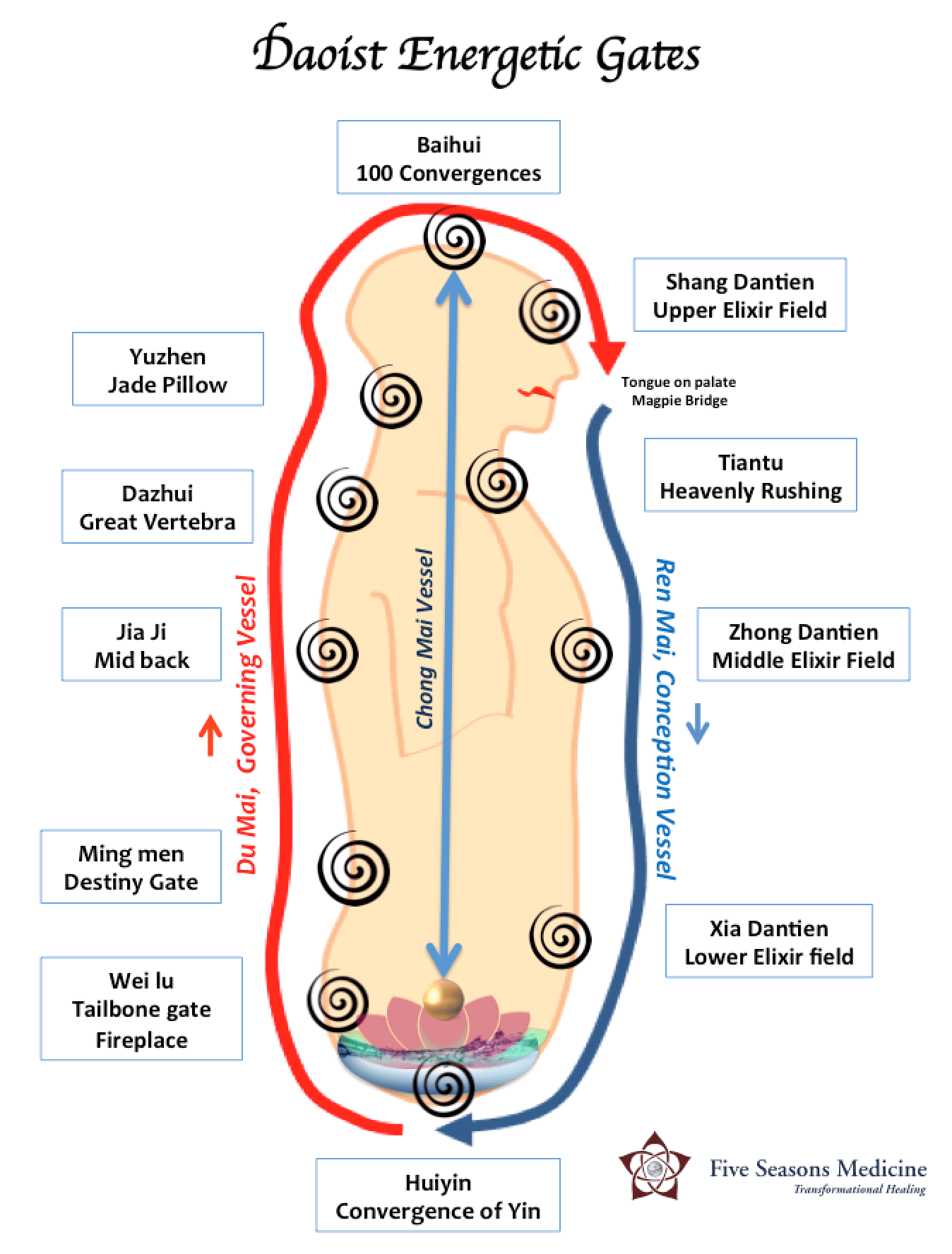
The three primary meridians shown above are part of the Eight Extraordinary meridians which are considered the spiritual, ancestral meridians that form in an embryo, and give rise to the twelve organ meridians. The Du Mai Meridian or Governing Vessel is seen as a central Yang channel. It flows up the back from the base of the pelvis, around the top of the head, ending at the upper lip. The Ren Mai or Conception Vessel is seen as a central Yin channel, flowing down the front from the lower lip to the base of the pelvis. The Chong Mai, or Thrusting Vessel connects the top and bottom of the body vertically up and down from Huiyin to Baihui.
| Gates | English translation | Acupuncture Point |
| Huiyin | Convergence of Yin | DU-1, Ren-1 |
| Wei lu | Tailbone Gate | DU-2 |
| Ming Men | Gate of Destiny (Jing) | DU-4 |
| Jia Ji | Mid Back | DU-9 |
| Dazhui | Great Vertebra | DU-14 |
| Yuzhen | Jade Pillow | DU-16 |
| Baihui | 100 convergences, Crown Chakra Link to Heaven | DU-20 |
| Shang Dantien | Upper Elixir Field (Third Eye) | Yin Tang |
| Da Qiao | Magpie Bridge (Upper lip meeting point of Du,Ren) | DU-27 |
| Tiantu | Heavenly rushing | Ren22 |
| Zhong Dantien | Mid Elixir Field | Ren17 |
| Xia Dantien | Lower Elixir Field | Ren-6 |

This drawing of the ancient Circulation of the Light, as taught in the Secret of the Golden Flower, shows the gates in relationship to hexagrams of the Book of Changes, the I-Ching. “The work on the circulation of the light depends entirely on the backward-flowing movement, so that the thoughts are gathered together. The heavenly heart lies between sun and moon.”
The Circulation of the Light or the Cosmic Heavenly Circuit was revealed by Guan Yinshi, the True Man of the Beginning of Form. “When the light is made to move in around the body in a circle, all the energies of heaven and earth, of the light and the dark, are crystallized in balance.”
[The Secret of the Golden Flower of Lu Dongbin as translated by Wilhelm / Baynes]
The kundalini is often depicted as a snake-like energy rising up the spine, like a serpent coiled at the base of the spine. When the kundalini is awakened, the snake uncoils, rises up, and creates a flowering and protection over the head, often depicted as a hood of snakes. It is said that Gautama Buddha was protected by a Mucalinda nāga, a snake being.
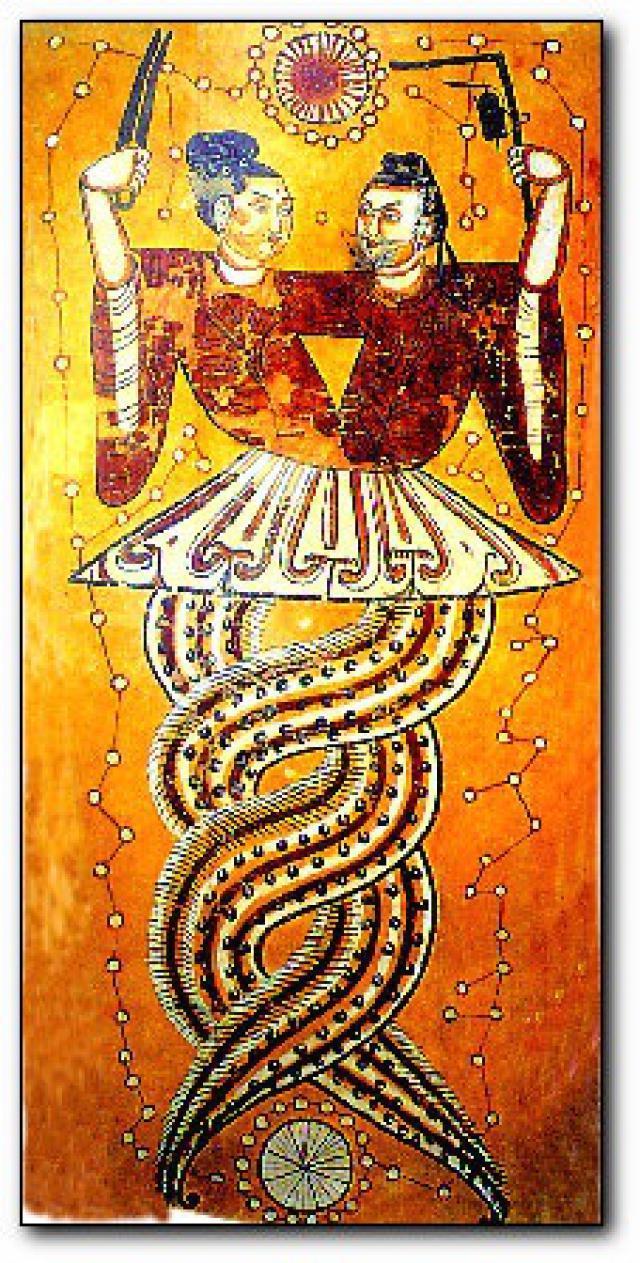 Mythological ancestors Fuxi and Nuwa are said to be the male-female root creators of the Chinese people and civilization after a great flood. They are shown here as intertwined snake creatures.
Mythological ancestors Fuxi and Nuwa are said to be the male-female root creators of the Chinese people and civilization after a great flood. They are shown here as intertwined snake creatures.
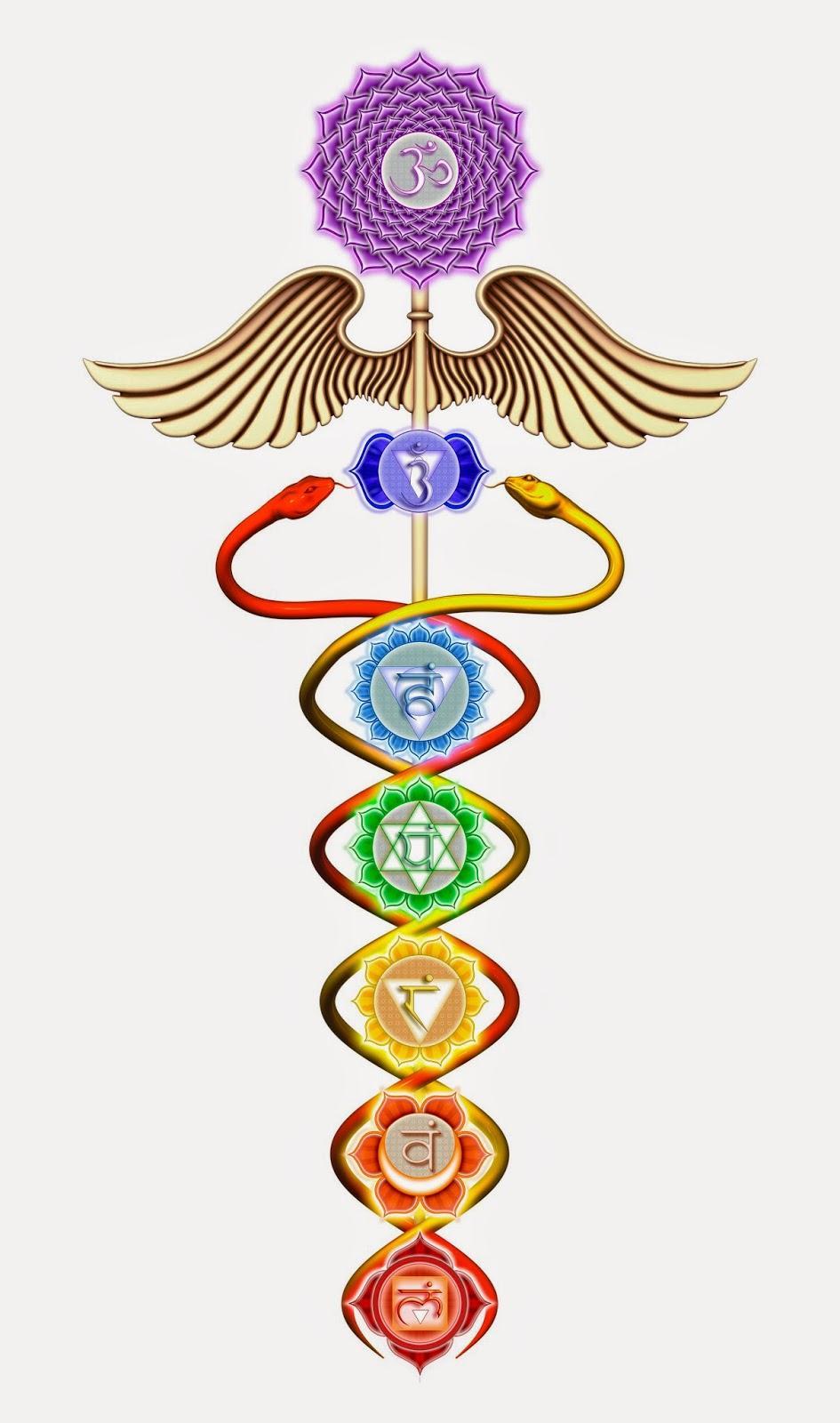
The caduceus is the staff said to be carried by Hermes in Greek and Egyptian mythology. It is a short staff entwined by two rising serpents, sometimes surmounted by wings. It is similar to Indian naga or serpent sculptures, and suggests the ascending kundalini encircling the chakras.
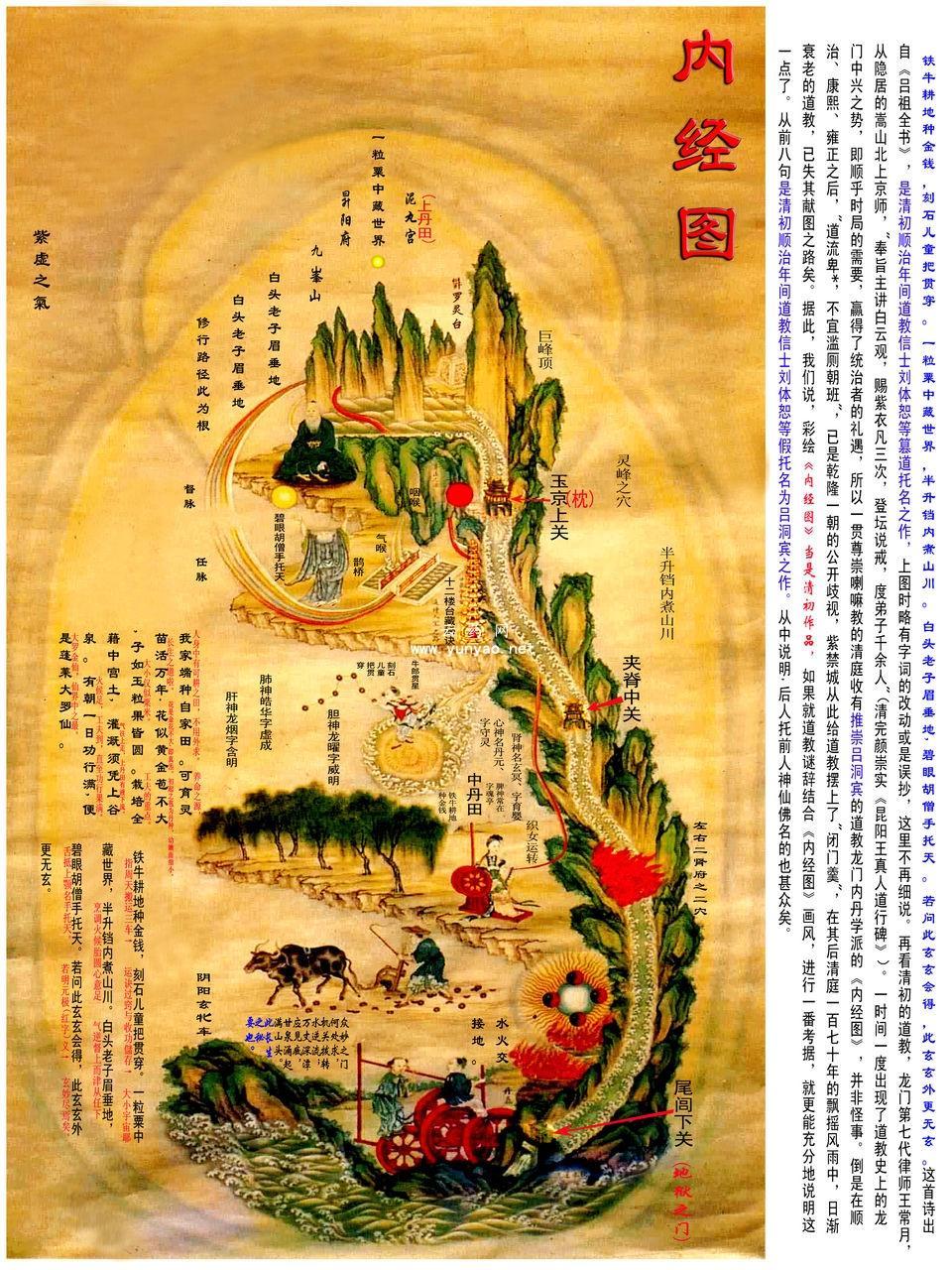
The Neijing Tu, or Inner Channel Diagram from the Yuan dynasty (1271-1368) is one of the most sacred ancient Daoist treasures of Internal Alchemy. It depicts the human energy body, and poetic map of the secrets of energy work. This image preserves a wealth of understanding about energetic cultivation and immortality. This stone carving exists at the White Cloud Temple in Beijing, and Wu Dang Mountain in Hubei Province.
The Neijing Tu shows the human body as a microcosm of Nature with mountains, rivers, paths, forests, and stars. Look closely and you will see the organs, skull, spinal column. The head as shows Kunlun Mountain. The upper dantien is the ‘cinnabar field’. Chinese constellations appear, such as the heart as Niulang “the cowherd” “Altair” holding the Beidou “Big Dipper”. Together with his archetypal lover Zhinü “the weaver girl” “Vega”, they propel qi up to the trachea or the Twelve-Storied Pagoda. The liver and gall bladder are a forest, and the stomach a granary. In the intestines “An iron ox ploughs a field where coins of gold are sown”, referring to cultivation of internal Elixir of life. At base of the spine are treadmill waterwheels run by a little boy and girl, representing yin and yang.
Along with Xi Sui Jing (洗髓經) other similar techniques exist, such as Yi Jin Jing (易筋經), also thus named according to the name of the main work on this subject ‘ ‘Treatise on the Change of Tendons (and Muscles)’, Liu Zi Jue (六字訣) – ‘Incantation by Six Characters’ (art of conducting sung songs through the organs and tense meridians), Chi Shui Xuan Zhu (赤水玄珠) ‘ ‘Secret Pearl of Red Waters’ and others. In contemporary China, all these techniques are grouped one way or another under the term of Qi Gong (氣功) – literally translated as ‘work (with) energy’, and are mainly used for sanitary and curative purposes, though in former times they were used sometimes for exactly the opposite purposes (8).

“Without detracting from W.G.Sutherland’s merit we have to mention the centuries – old practice in Chinese medicine called Xi Sui Jing (洗髓經) ‘Washing the Brain’ , used for spiritual enlightenment, improving health, increasing vitality, and conditioning the body.”


